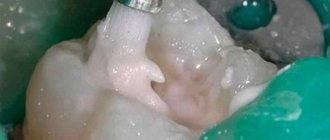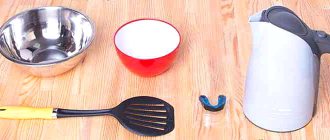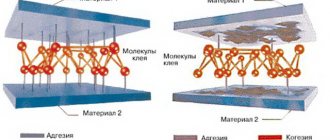It is not always possible to treat a tooth in one visit - if the caries is complicated and the root canals are inflamed, the doctor puts a temporary filling under which he puts medications. It prevents medication from falling out, protects the treated dental cavity from food debris and microbes.
A temporary filling is made of a looser material. It is plastic and does not dissolve in water. For filling, dentin paste, sympath, vinoxol, and zinc-polyacrylate cement are used. The doctor chooses the material, taking into account the diagnosis and the condition of the tooth.
Temporary filling is used for prosthetics, if caries has not reached the nerve, when the nerve is removed. A filling is also installed in the following cases:
- treatment of pulpitis, periodontitis;
- deep caries;
- removal of a tooth root cyst;
- multi-stage therapy;
- making a dental stump inlay when installing a crown.
The period of wearing a temporary filling usually does not exceed 1-1.5 weeks, but sometimes it can be extended up to six months. The dentist determines it exactly.
Sometimes, after installing a temporary filling, patients complain of discomfort and pain. Why does pain occur, how to deal with it?
Why does a tooth hurt after installing a temporary filling?
Pain and discomfort can be a normal reaction, which occurs in 60% of patients, but sometimes pain indicates pathology, inflammation, and complications. After filling, you need to listen to your feelings; if your condition worsens, be sure to consult a doctor.
Installing a temporary filling may cause pain due to treatment and tooth preparation. Natural causes of pain:
- irritation, tooth trauma during cavity treatment, drug installation;
- the effect of medications on the dental pulp;
- the effect of necrotizing agents on the nerve, pulp until the death of nerve endings;
- increased tooth sensitivity, exposure to cold or hot food.
Temporary pain occurs in the first few days after treatment, it is short-lived, the intensity of the sensation gradually decreases, the tooth “aches”, but without excessively painful sensations. How long a tooth hurts after installing a temporary filling depends on the disease: during the treatment of caries it may not appear, but with pulpitis it goes away within one to two weeks. Dental gels and special pastes that reduce tooth sensitivity will help alleviate the condition.
Sometimes, under a temporary filling, severe tearing pain occurs, which intensifies at night. If such sensations are accompanied by other symptoms - swelling of the cheek or gums, numbness of the jaw, increased temperature, this indicates the development of complications. In this case, you need to consult a doctor as soon as possible.
How long can a temporary filling be used?
Many patients have a reasonable question: how long can they walk with a temporary filling and how long can it stay in the tooth cavity.
Depending on the indications for treatment and its composition, the installation period for a temporary filling can range from 1 day to six months. The filling will not last for more than 6 months, so your visit to the dental clinic should be planned in advance (in case of long trips or business trips).
If a temporary filling falls out, you should immediately seek advice from your doctor. Based on the examination, the dentist can make one of two decisions: if the treatment is at an incomplete stage, the doctor will place another temporary filling; A permanent filling will be placed if the medication wears off.
Be that as it may, “postponing the matter” is fraught with serious problems. Before visiting a specialist, you should thoroughly rinse your mouth after eating to avoid the entry of pathogenic bacteria into the open cavity, which can cause inflammation.
The cost of installing a temporary filling directly depends on its composition and the specific dental clinic and will range from 350 to 650 rubles.
This article is for informational purposes only, please consult your doctor for details! Ask your doctor about contraindications and side effects.
Possible complications after installing a temporary filling
Pathological processes or complications during treatment can arise due to an allergic reaction of the body, an incorrectly chosen treatment strategy, non-compliance with the period of wearing a temporary filling, or due to loss of medication.
- If the installation of a temporary filling was carried out after placing the drug in the tooth canal, pain may be a sign of an allergy, incorrect dosage of the drug, or incorrectly selected time of exposure. In case of allergies, the doctor replaces the cementing composition or medication.
- If the filling hurts when pressed, this indicates that the periodontal tissue is damaged.
- “Shooting” sharp pain is a sign of purulent pulpitis or tissue inflammation.
- If the pain occurs upon touching and is acute, there may be a piece of dental instrument left in the root canal. The cause of such sensations is also periodontitis.
- Night pain occurs with pulpitis.
Installation of a temporary filling is one of the stages of treatment, and not full-fledged therapy. Over time, such filling material falls out, food and microbes enter the tooth cavity, which leads to a worsening of the condition and the development of complications. In advanced cases, incomplete therapy can cause tooth loss.
Types of temporary filling depending on the material
The material used to install a temporary filling is non-toxic, environmentally friendly and does not pose any danger to the body. At the same time, it is quite plastic, can occupy any volume, and has the property of rapid drying.
Depending on the practical application, a temporary filling may contain different compositions, in particular:
- Artificial dentin.
It is the most common substance for making temporary fillings. It contains zinc oxide and kaolin. For quick hardening (up to 3 minutes) mix with a small amount of water.
- Dentin pastes.
Slightly increased hardening time of the substance due to the fact that essential oils are used instead of water (as in the case of artificial dentin).
- If there is a need for temporary filling of dental canals, a mixture of Karyosan is used.
- For pain relief
and relieving the inflammatory process, solutions based on zinc-evengel cement are effectively used.
What to do if your tooth hurts
Discomfort and pain in the first days after the procedure are normal. If pain persists, you should consult a doctor. He will perform diagnostics and give recommendations.
If it is impossible to see a dentist, the following measures will help alleviate the condition:
- taking analgesics - Ketorola, Naiza, Analgin: these medications will relieve pain;
- rinsing the mouth with herbal infusions based on chamomile, sage, eucalyptus: the plant material is poured with boiling water, left for about an hour, cooled and filtered;
- rinsing the mouth with a solution of soda and salt;
- you can make a lotion from valerian infusion: soak a cotton swab in the infusion, apply to the gum next to the damaged area;
- if swelling has developed as a result of inflammation, antihistamines will help reduce it;
- Gels containing painkillers will help eliminate discomfort.
Important: these are temporary measures designed to alleviate the condition, and not an alternative to going to the doctor. Visit your dentist as soon as possible!
About temporary filling
There are quite a few cases where, after this filling has been placed, the patient continues to complain of prolonged pain in the tooth area. This phenomenon is most often considered normal, but only if the installed filling was actually temporary and not permanent. Many patients who have delayed dental treatment for too long may encounter this problem, since in advanced cases, the medication installed under the filling cannot immediately cope with the pain. In this case, a second visit to the dentist is recommended.
Installing a medication under a temporary filling is simply necessary for certain serious diseases of the oral cavity, for example, pulpitis, periodontitis or widespread advanced caries.
Sometimes a person experiences discomfort after having a temporary filling installed.
Most often, the presence of mild persistent pain after the placement of a drug under a temporary filling is absolutely normal, as the tooth is subjected to drug therapy. At this time after the procedure, the nerve roots inside the tooth pulp still tend to react to external stimuli, which is why in the first time after the procedure the medicine and the filling mass tend to cause mild pain.
Pain that occurs during the first time after the procedure is normal, but there are cases when the pain continues to persist after the end of dental therapy. In this case, the patient needs to contact a specialist again, because the presence of such a symptom may indicate any errors made during treatment. If you do not consult a doctor for re-treatment, then the patient runs the risk of serious complications.
Important ! The main causes of pain after the filling has been installed are insufficiently tight installation of the filling material, incorrect or insufficient disinfection during the procedure, incorrect treatment or the occurrence of re-infection after the procedure. If such a problem exists, the patient should immediately consult a doctor, and in no case self-medicate.
Pain may indicate improper treatment
When to see a doctor
If a tooth under a temporary filling constantly hurts, and the pain is bursting in nature and intensifies at night or during the day, you need to consult a dentist as soon as possible. The doctor examines the damaged tooth: if the filling has fallen out, he will put a new one and replace the medication. If the pain is caused by the development of inflammation or infection, the dentist will take action and change the treatment strategy.
You should immediately consult a doctor in the following cases:
- pain is accompanied by a feeling of swelling of soft tissues;
- the gums or cheek turn red, swell, and swelling appears;
- body temperature rises;
- the intensity of pain does not decrease within several days;
- when exposed to high or low temperatures, the pain intensifies;
- signs of general intoxication of the body develop;
- lymph nodes (primarily submandibular) enlarge and become painful on palpation;
- there is an unpleasant odor from the mouth;
- The temporary filling falls out, its tightness is compromised: cracks and chips form in the cementing material.
In such cases, the dentist will open the filling, remove the medicine and any remaining filling material. The doctor will disinfect the hole, clean and dry the root canals. If necessary, seal them with sealer and install a pin. After such treatment, an x-ray is performed - it allows you to evaluate the quality of treatment. Next, the dentist can re-install a temporary filling or change therapeutic methods.
How long can you walk with a temporary filling? 3 determining factors
A temporary filling, unlike a conditionally permanent filling, is less durable. It is installed for a short period of time. But only a doctor can say exactly how long to walk with a temporary filling. The period differs in individual situations. Much also depends on the patient.
How long does it take to place a temporary filling for various diseases?
Let's start with why a temporary filling is needed in the first place. Why not immediately install a good one for a year? Contrary to popular belief, a filling is not only used at the final stage. The dentist also places it during the treatment process.
- Additional diagnostics. Any doctor will strive to preserve the nerve of the tooth. Therefore, if there is a possibility that the lesion has not affected it, then the nerve is left intact. It is temporarily closed with a filling after treating the source of inflammation. If the tooth continues to hurt, the nerve is removed and a permanent filling is installed in place of the temporary one. How long will it take to wear a temporary filling in this case? About a week.
- Drugs. The filling can also cover the tooth tissue while the drug is absorbed. It prevents the entry of bacteria and the development of infections. You will have to walk with a temporary filling for 5-14 days.
- In case of inflammation of the roots, fillings are placed for up to 3 weeks.
- You can walk with a temporary filling for up to several months. This is usually necessary when the patient cannot visit the doctor in the near future. Long-term treatment with fillings is also necessary for cysts and granulomas.
The material determines how long you can walk with a temporary filling
After the examination, the doctor determines the treatment method and how long to walk with a temporary filling. According to this, he selects the material. The compositions differ in their strength.
- Dentin is used for the shortest possible time. The material is quite cheap, but short-lived and unaesthetic. In just a week, the filling wears off by several mm. And light white color rarely matches the natural shade of teeth.
- Cements. You can walk with a temporary cement filling for longer, up to 2 months. The material also stands out against the teeth due to its light color.
- Light-curing material is used for permanent fillings. But it is also suitable for temporary ones. It is worth understanding that if a doctor installed a filling as temporary, this does not mean that the next doctor’s visit can be skipped or postponed. The filling must be replaced on time.
How does a patient influence how long to walk with a temporary filling?
The patient's attitude towards the filling affects its service life. Although the filling is installed only temporarily, it is not worth the risk. Neglect will cause the filling to fall out, wear off, or crack. I'll have to make an appointment with the dentist again. And, what is much worse, pain, inflammation and infections will appear. To extend the life of a temporary filling:
- Use a soft brush
- Avoid sticky and viscous foods (chewing gum, toffee, nougat)
- Don't chew hard objects
- Don't use bleach
In general, you can walk with a temporary filling from 1 day to several months. Only a dentist can say for sure.
In what case is a temporary filling installed?
Of course, any patient of a dentist would like his problem to be solved in one visit.
But in some cases, treatment has to be divided into several stages. Opening a tooth cavity and installing a temporary filling occurs in the following cases: 1. Diagnosis and determination of treatment tactics in case of advanced conditions.
The doctor can install a temporary filling on an opened tooth cavity in the presence of advanced carious processes in order to determine the degree of destruction of dental tissues and the sensitivity of nerve endings.
To do this, after treating the opened cavity, a temporary filling is installed for several days, during which the patient monitors the frequency and intensity of pain. If they are not there, a permanent filling is installed during a follow-up visit. If present, then the treatment is continued and only after it the tooth is filled. 2. Nerve killing
In case of pulp damage, the damaged dental nerve is killed using potent drugs.
The tooth cavity with the medicine is sealed with a temporary filling. The period for which the drug is left in the dental cavity is determined by the attending physician. It can take from two to twenty days. During this period, the patient must monitor his condition and come for an appointment strictly on time prescribed by the doctor. Despite the fact that the materials from which temporary fillings are made are quite strong and can withstand chewing loads, it is still recommended to avoid eating foods such as nuts, fruits with seeds, etc. 3. Treatment of periodontitis
With periodontitis, not only the root of the tooth is affected, but also the area of tissue near which it is located. Since the inflammatory process occurs in the root canals, their gradual cleaning and deep antiseptic treatment are necessary. Drugs that relieve inflammation are placed in the cavities, and they are also sealed with a temporary filling for the time required for the drug to act.
What is a temporary filling
The main function of a temporary filling is to prevent pathogenic oral flora from entering the tooth cavity at an intermediate stage of treatment. Also, with the help of a temporary filling, a hole in the tooth is isolated when potent compounds are placed in it to kill the dental nerve.
The installation of a temporary filling is always preceded by preliminary treatment of the diseased tooth: opening the dental cavity, removing dead tissue, cleaning and antiseptic treatment of the resulting cavity. Installing a temporary filling allows the patient to wait for the next stage of treatment without reducing the quality of life.











